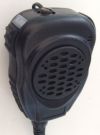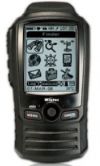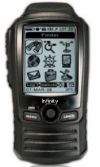
Tracking your Teams with GPS Microphones
This
document will explain the different options of Tracking of
Teams in the field, using GPS microphones. These microphones are
connected to your standard VHF Voice radios, using the appropriate
interface cable for the radio. They will then transmit the GPS location of the unit
as a short databurst over the Voice channel in various (optional) ways.
For
more information of the pro's and con's of using GPS Microphones as
opposed to APRS, Satellite and SmartPhone trackers, please take some
time reading the document How to Track your Teams.
The basics:
The GPS microphones will transmit a burst of data over the Voice radio channel to transmit their location.
One GPS mike connected to a handheld radio
(which itself should be connected to an external antenna) will be used at a SARTrack laptop at
the Base to receive the tracking data from the other GPS mikes in the field.
SARTrack will convert the location data to APRS format, and transfer this to all other connected SARTrack computers.
Currently SARTrack supports decoding of (almost) three different GPS microphones:
GPSMic  WinTec(2006)
WinTec(2006) Infinity
Infinity
The
Infinity (also ICOM RedHawk), while it looks the same as the original
WinTec, is a completely rebuild microphone, produced by a different
company, and with a totally different PC interface. This is SARTrack
work-in-progress.
SARTrack currently recommends the GPSMic ST_GPS4100P as the best microphone for SAR operations.
The reasons for this are:
- It is fool-proof, and suitable for all non-technical Team users in the field.
- It is highly configurable with its configuration software (see details below)
- It has a 'Priority/Panic' button.
- It has adaptors and interface cables for nearly every radio available, with a quick-release connector.
- Its is automatically switched on and off with the connected radio.
- It is relatively cheap (see below).
While
we have not yet had access to the Infinity mike, we have tested
the 2006 WinTec. The problem with these types of microphone is the fact
that non-technical users will make mistakes trying to operate it, stuff
up the settings, and make the microphone inoperable for the duration of
the SAR operation. This mike would only be usable by people with
good understanding of the many options.
As the three
microphones all use a different radio protocol, you cannot mix
them on the same radio channel and decode them on the same SARTrack
computer.
GPSMic ST_GPS4100P capabilities
The microphone can be extensively programmed using the included configuration program, which includes an excellent Help file.
It is also possible to program the mikes over the radio, but this is not (yet) incorporated in SARTrack.
Amongst the many options, the mike can be programmed to:
- Transmit its position based on time;
- Based on distance traveled (programmable)
- Based on moving out of an circulair area (programmable)
-
Based on PTT, with the option to limit this for a certain time,
eg after one PTT release, do not send another position for X seconds.
This will greatly reduce the amount of data bursts transmitted
over the voice channel.
- Based on a Poll (request) from a SARTrack computer (of the same SAR Group)
-
Based on the 'Panic' button. When this button is pressed for 3 seconds
(programmable), it will start transmitting its position every minute
(programmable), with a 'priority' tag. This will cause all SARTrack
computers to tag it in Red, and start the visual/audio alarm.
In
addition to this, when the mike gets into a Low-Battery state, this
will tag the position reports as well, and a 'Low-Batt' warning will
show up on SARTrack. This will enable Operations to warn the user to
replace the battery. (The mike also emits a warning ringing tone and
flashes its LED red). Whe the battery is dead, the mike will perform
normaly, but wil no longer send position reports.
The mike can be
programmed to store all transmitted waypoints in memory, where they can
later be downloaded with the supplied software. We have not tested this.
The build-in GPS uses a WaveFar passive antenne in the top of the microphone, with a S1315R GPS chip.
It
has a cold start of 30 seconds and a hot start of 1 second. It will
re-aquire the satellite in 1 second after an interruption. It is
extremely sensitive and will work under foliage and in canyons.
GPSMic ST_GPS4100P known issues.
-
The microphone has been developed some years ago, is considered to be
stable, and no further development is taking place. This means any
technical issues regarding compatibility with some radios cannot be
solved.
The factory in Taiwan builds the microphones on demand,
using the existing hardware, firmware and software. They DO make
additional new Radio adaptors/cables on request.
The 'Data burst
Mute' is not very good, on those radios where it actually works, it
will reduce the data burst from is full 670 ms length to about 100 ms
length.
While the microphone comes with a huge range of adaptors for
many different radios, not all of them work as well, and some may not
have been tested. You should therefore first test the microphone
with the radios you plan to use. New Zealand users, contact SARTrack if
you want to check your radios against the mike. We can test them for
you if you send us two radios, and pay for freight and the possible
purchase of the required adaptors.
GPSMic ST_GPS4100P current pricing
As at February 2014, the microphone can be purchased direct from the factory in Taiwan for US$150 plus freight. The adaptor/cable costs approximately US$10. There is also a dealer in the Netherlands.
You will have to pay sales tax in your country.
We
got the 2 test mikes send to us by DHL within 3 days, but for such a
small amount of microphones, the freight is out of proportion to the
cost of the microphones themselves. It therefore pays (excuse the pun)
to coordinate the orders with several SAR groups at the same time.
SARTrack has tested the mike on the following radios:
- Tait TP8100.
Works well, but the data 'Mute' does not work. As this radio has an
actual automatic volume control for the microphone input, the GPSMic
must be programmed to severely reduce the mike sensitivity. This to
prevent the Tait radio regulating the mike volume way back, with as a
result the following data burst will not get through.
- Vertex VX-824. Works well, data mute works.
- Yaesu VX-170. Works well, data mute works. This radio requires the use of the ICOM cable, and the Yeasu VX-170 adaptor cable to be connected together.
- Vertex VX-160. Works. Mute not tested.
- ICOM IC-F3S.
We could not get this radio to work properly with the microphone.
When incoming voice traffic would be a bit loud, the mike would
cut off the sound. It seems to have to do with the fact that the
incoming voice is send back into the radio via the microphone
input connector, and the radio does not like that.
GPSMic factory: http://www.mobilitysound.com/gpsmic.htm
Orders, Information and help: sam@mobilitysound.com
------------------------------------------------------------------------------------------------------
The WinTec (2006).
SARTrack supports the decoding of the GPS data from this microphone, but not any other information. SARTRack can also not
send a Poll request to the radios. As this microphone has not been sold
or supported after 2006, no more development will be done in SARTrack.
The Data Burst Mute of this microphone reduces the 330 ms burst down to
about 50 ms.
The WinTec has been tested on the ICOM IC-F3S and the Yaesu VX-170 and works well on these radios, including the Mute.
------------------------------------------------------------------------------------------------------
The Infinity / ICOM RedHawk.
SARTrack
has obtained the licenced protocol document to be able to decode and
communicate with this microphone, and we are currently trying to get
our hands on a couple of them for testing.
LINKS:
GPSMic factory: http://www.mobilitysound.com/gpsmic.htm
Infinity Brochure (PDF) Link
Infinity Presentation (PDF) Link
Februari 2014
Bart Kindt
SARTrack Limited
http://www.sartrack.co.nz/


 WinTec(2006)
WinTec(2006) Infinity
Infinity